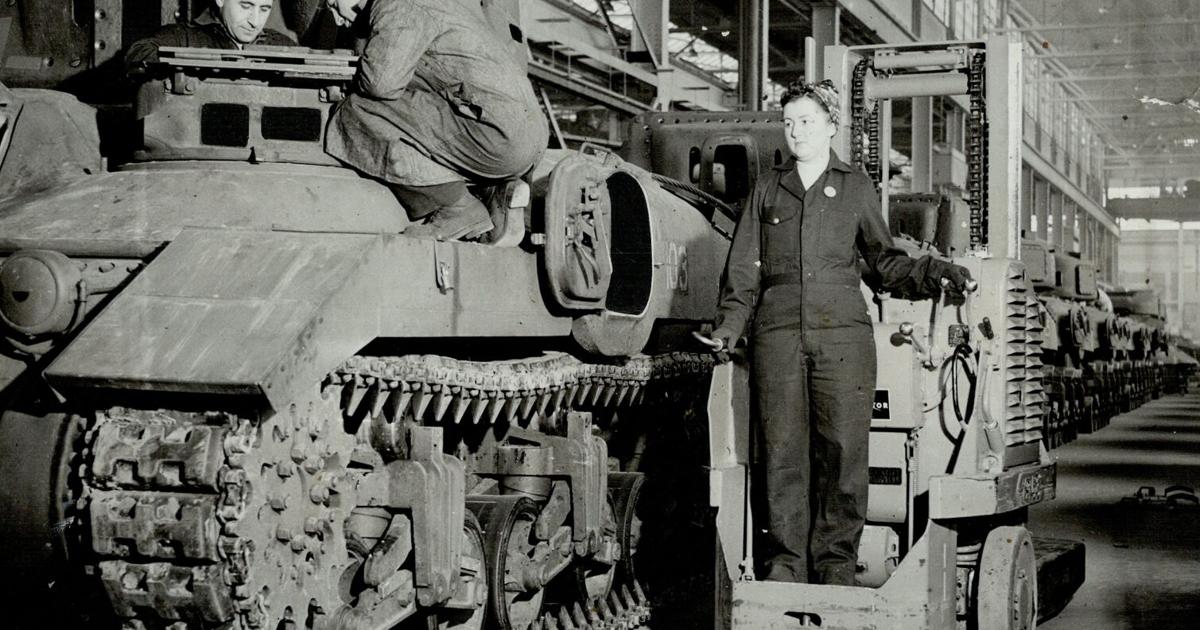Copyright thestar

During the Second World War, hundreds of Canadian businessmen volunteered their services to lead Canada’s wartime economy. They were known as “dollar-a-year” men. The vast majority were not actually paid a dollar each year, but they did play a significant role in transforming Canada into the fourth largest industrial power in the world. In this adapted excerpt from “The Dollar a Year Men: How the Best Business Brains in Canada Helped to Win the Second World War” the story of Harry Carmichael, who was head of wartime production, is chronicled. There were few issues that Harry Carmichael could not solve. A soft-spoken and lanky man with a serious face, distinguished by a high forehead, receding hairline, and long nose, he had a presence. “He is stern in business, square in dealing, demands square dealing of others and, punishes relentlessly any deviation therefrom; has a streak of genius in his ability to do business successfully, in other words to make money, and absolutely no interest whatever in the ‘show’ of spending money,” wrote journalist Corolyn Cox in February 1941 in one of the many profiles she penned about the dollar-a-year men who served in the federal Department of Munitions and Supply led by C.D. Howe, the all-powerful cabinet minister in William Lyon Mackenzie King’s government. “His secret seems to be that his mind is serene and clear with an enormous capacity for grappling with many things at the same time,” added Wallace Ward in a 1945 article about Carmichael for Liberty magazine. No dollar-a-year man grasped the intricacies of pre-1950 production technology more than Carmichael. In his youth, he worked on a shop floor and never forgot the various challenges faced on a daily basis by his fellow labourers. As an executive at General Motors of Canada (GMC), he was an expert on the mechanics of the assembly line. Most important of all, when it came to Canadian production during the war, Carmichael saw the big picture. Howe and Munitions and Supply could not have found a more suitable choice to co-ordinate and head wartime production than him. “Harry Carmichael is proving to be invaluable,” Howe told R.A.C. Henry, one of his chief dollar-a-year men, in late November 1941, “and he has brought some excellent men into the department.” Civil engineer C.J. Mackenzie, president of the National Research Council of Canada, was more effusive, telling Howe that Carmichael was “the best man I have seen around Munitions and Supply.” His father, William, a British engineer, and his mother, Mary, were living in New Haven, Conn., in September 1891 when Harry was born. He was their third child of six and one of five sons. As a teenager, Carmichael honed his skills as a baseball player and was a superb catcher. He had dreams of becoming a professional, but a minor injury to his throwing arm prevented that from happening. Instead, in 1908 he embarked on a career in business with a local hardware firm for a salary of $25 a week. Four years later, he relocated to St. Catharines, Ont. for a job as a pattern maker for McKinnon Industries, a company that produced hardware equipment. Owner Lachlan McKinnon and his managers hoped that Carmichael would be a star player on the company baseball team. He performed as expected on the field, and the decision to move to Canada changed Carmichael’s life. In the years after the First World War, McKinnon Industries transitioned into the more lucrative manufacturing of parts for the growing automobile industry. The firm’s success attracted the attention of General Motors, which bought it out in 1929 and operated it as a subsidiary. By then, Carmichael had been promoted to McKinnon’s president and general manager. Impressed by Carmichael’s leadership skills, General Motors appointed him vice-president and general manager of its whole Canadian subsidiary in 1936, and he moved to the company’s head office in Oshawa. Early in 1941, keen to do his part and contribute to the Canadian war effort, Carmichael resigned from GMC and arrived in Ottawa initially to serve as the deputy of the newly created Wartime Requirements Board. The company acknowledged its loss: “We are making a very great sacrifice,” its president R.S. McLaughlin, stated. “But this appointment may well be of supreme consequence in our country’s all-out war effort. I have always considered Harry Carmichael one of the most efficient executives in Canada and one of the most modest.” That prediction was to prove true, as Carmichael impressed everyone who he worked with or encountered as a dollar-a-year man. This included Howe, who accepted a recommendation that Carmichael be given more responsibility for Munitions and Supply’s production. Carmichael was also one of those small number of dollar-a-year men who covered his own expenses. For example, at the end of May 1942, after being reimbursed for travel he had taken on behalf of the department, he immediately returned the funds. Carmichael’s reign as Canada’s wartime production czar evolved in several stages. On February 1, 1941, Howe announced at a press conference that Carmichael was succeeding Toronto entrepreneur E.P. Taylor (who briefly became Howe’s executive assistant) as co-director (with William Drysdale of Montreal) of munitions production, and would be the senior director general in charge of guns, shells, tanks, and bombs — despite the fact that he had no real prior experience with munitions. What he did possess was business acumen. “Mr. Carmichael is a manufacturer who knows how to get things done,” an editorial in the Globe and Mail noted a few days later. “It will be his job to go into any factory where output is lagging and correct what is wrong. He can do this because he is a practical man of outstanding experience.” The following week another article touted Carmichael as “Canada’s No. 1 troubleshooter.” The gun production division or branch was still in its infancy in early 1941. Carmichael asked the British to send to Canada a hundred skilled mechanics in order to expand production. “The blueprints and products often didn’t go together; the Brits knew the shortcuts and unofficial adjustments that were necessary,” he later remembered. At first, Canada was dependent on British technology. Then, Carmichael was able to employ American mass production techniques. By the end of the war, “Canada became self-reliant,” he remembered. Despite dealing with a myriad of problems, Carmichael achieved results. From February 1941 to the summer of 1942, when his focus was primarily on the production of guns and small arms, the number of rifles, pistols, and machine-guns increased substantially. In 1941, 6,847 rifles and pistols were produced; that number jumped by more than 3,100 per cent, to 220,240, in 1942; and then to 394,349 the following year. Similarly, 17,860 machine guns were produced in Canada in 1941; 93,102 in 1942; and 159,918 in 1943. In the fall of 1941, a second reorganization at Munitions and Supply led to Carmichael’s appointment as chairman of the munitions production committee. Up to that point, the various directors general of the production branches — who oversaw the production of everything from aircraft to guns to ships — met several times a month to review shared problems, although these meetings had not been formalized. With Carmichael now heading this new committee, policies became more uniform, new projects were recommended, and he adopted a broad perspective in solving production issues. “We had to make a great many changes to get things working,” he recalled. To this end, he recruited divisional heads from GMC, Westinghouse, and General Electric. Less than a year later, Carmichael’s administrative power was expanded further. He became “Co-ordinator of Production and Chairman, Production Board.” Now, the heads of the production branches and Crown corporations (established during the war to ensure the availability of supplies and equipment) “were directed to collaborate with the Co-ordinator and to furnish him with such information, respecting their programmes as he might require for the purpose of planning and co-ordination.” Under Carmichael’s leadership, plants were expanded and retooled, and technology was upgraded. As an example, CCM, known before (and after) the war for manufacturing bicycles and hockey skates, reinvented itself to produce gun parts, tripods for Bren guns, and cradles and pivots for anti-tank guns. Similarly, in Quebec, Liquid Carbonic Canadian Corporation’s soda fountain division was transformed to construct parts for tanks. Years later, Carmichael noted that “we ended the war with the finest quality armaments and the lowest unit cost in the world.” In an article Carmichael wrote about Canadian war production for the winter 1943 issue of Quarterly Review of Commerce — a journal published by the University of Western Ontario — he offered further examples of how he had guided Canadian companies in transforming themselves for the war effort and influenced the work of dollar-a-year men leading other production departments. He related how a Canadian factory that made dome fasteners was now producing ammunition. Workers at a plant that manufactured refrigerators became experts on producing tank turrets. A former streetcar factory was making parts for bombers. “Of all the hundreds of Canadian industrial plants now making munitions and supplies of war,” he wrote, “only two were turning out exactly the same products three years ago.” Much of Carmichael’s success — and that of the private manufacturing companies producing war equipment and materiel — was due to his implementation of a technique that had proven effective at GMC: subcontracting. The complex work of producing a multitude of components was accomplished by allocating these various tasks to hundreds of skilled labourers at smaller shops spread across the country. Howe liked to refer to this as the “bits and pieces” system. Carmichael was enormously proud of what had been accomplished. He had no regrets, calling his time in Ottawa and the very long days he put in, “the greatest experience and greatest thrill of my life.” This was despite the toll it took on his health. “It has been an amazing feat of expansion, adaptation and improvisation,” he wrote in 1943. He touted the ingenuity and vision that enabled Canadian industry to meet production targets. “Canada has achieved something of an industrial miracle in converting and expanding its peacetime production capacity to wartime needs,” he explained. “Factories that once made trucks and pleasure cars are making armoured vehicles.” Carmichael could point to the production of machine guns, aircraft, and cargo ships in numbers that were never thought possible. He never took workers for granted, as a Globe and Mail editorial noted upon his retirement from government service in October 1945. The newspaper’s editors praised his “industrial ‘know how,’ his practical knowledge of shop methods and a flair for simplified practice (which) enabled him to give leadership in ironing out the kinks and clearing the way to rapid development in many lines of production.” Carmichael, the editors added, “gave the greatest official stimulus to labour-management production committees, which, in turn, did much to extend the simplified practices that led not only to greater production but frequently to substantial savings in unit costs … He leaves public office in much better health than when he entered it.” Excerpted from “The Dollar a Year Men: How the Best Business Brains in Canada Helped to Win the Second World War” by Allan Levine. Copyright © 2025 by Allan Levine. Published by Barlow Books. Reproduced by arrangement with the publisher. All rights reserved.



